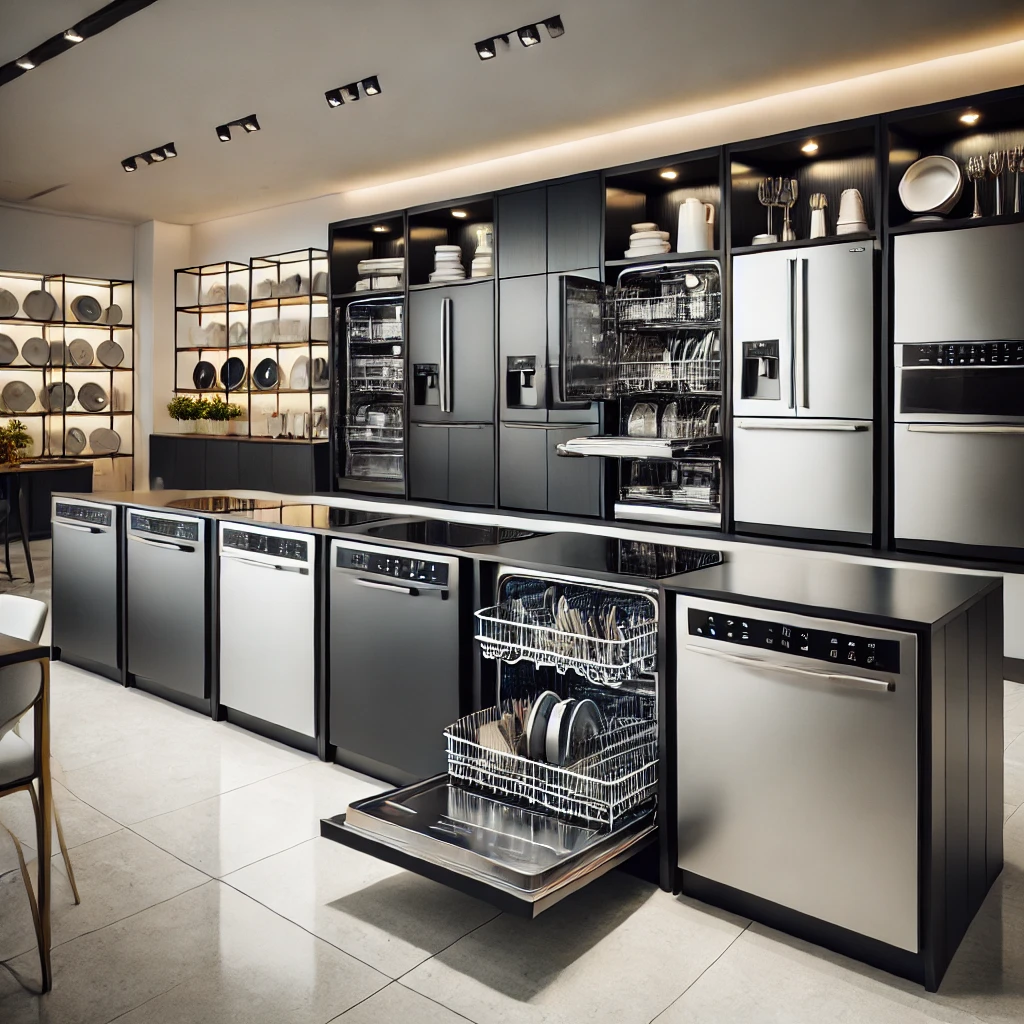What is a Built-In Dishwasher?
A built-in dishwasher is a kitchen appliance designed to be permanently installed under the counter and integrated into the cabinetry. Unlike portable or countertop dishwashers, built-in models are fixed in place and connected directly to the home’s plumbing and electrical systems. This integration allows for a seamless look and efficient use of space, making built-in dishwashers a popular choice for modern kitchens. They typically come in standard sizes, but there are also compact versions available for smaller spaces. Built-in dishwashers often feature a front panel that can be customized to match the surrounding cabinetry, enhancing the overall aesthetic.
Pros of Built-In Dishwashers
Space-Saving Design
One of the most significant advantages of built-in dishwashers is their space-saving design. By being integrated into the cabinetry, they free up valuable floor space that can be used for other purposes. This is particularly beneficial in smaller kitchens where every square inch counts. The built-in design also means that the dishwasher is always in a fixed location, making it easier to plan the layout and ensure that all appliances and storage areas are optimally placed.
Aesthetic Appeal
Built-in dishwashers are designed to blend seamlessly with the rest of the kitchen, contributing to a cohesive and polished look. Many models offer panel-ready options, allowing homeowners to attach a custom front panel that matches their cabinetry. This creates a uniform appearance and can make the dishwasher virtually disappear into the design. Additionally, built-in dishwashers often have sleek, modern designs with stainless steel finishes and hidden controls, further enhancing the aesthetic appeal.
Enhanced Functionality
Built-in dishwashers are known for their advanced features and enhanced functionality. Many models come equipped with multiple wash cycles, including options for heavy-duty cleaning, quick washes, and eco-friendly cycles. They also tend to be more energy-efficient, with many models earning Energy Star ratings for their low water and electricity usage. Noise reduction is another key feature, with many built-in dishwashers operating at very low decibel levels, making them ideal for open-plan living spaces where noise can be a concern.
Increased Home Value
Having a built-in dishwasher can potentially increase the resale value of a home. Prospective buyers often look for modern, well-equipped kitchens, and a built-in dishwasher is seen as a desirable feature. It adds to the overall appeal and can be a selling point in a competitive real estate market. Additionally, the presence of a built-in dishwasher can signal to buyers that the home has been well-maintained and updated with modern conveniences.
Customization Options
Built-in dishwashers offer a range of customization options to suit different designs and personal preferences. Panel-ready models allow homeowners to attach custom panels that match their cabinetry, creating a seamless look. There are also various sizes and configurations available, from standard 24-inch models to compact 18-inch versions for smaller spaces. Some built-in dishwashers even offer flexible interior layouts with adjustable racks and removable trays, allowing for greater versatility in loading dishes.
Cons of Built-In Dishwashers
Higher Initial Cost
One of the main drawbacks of built-in dishwashers is their higher initial cost. They tend to be more expensive than portable or countertop models, both in terms of the purchase price and installation costs. The need for professional installation can add to the overall expense, as it often requires modifications to existing cabinetry and connections to plumbing and electrical systems. This higher upfront cost can be a barrier for some homeowners, particularly those on a tight budget.
Installation Complexity
Installing a built-in dishwasher can be a complex process that requires professional expertise. It involves connecting the appliance to the home’s plumbing and electrical systems, as well as ensuring that it fits properly within the existing cabinetry. This can sometimes require modifications to the layout, such as cutting into cabinets or adjusting countertops. The installation process can be time-consuming and may require the services of a plumber, electrician, and carpenter, adding to the overall cost and complexity.
Lack of Mobility
Unlike portable or countertop dishwashers, built-in models are fixed in place and cannot be easily moved. This lack of mobility can be a disadvantage for renters or homeowners who may need to relocate in the future. Once installed, a built-in dishwasher becomes a permanent fixture, making it difficult to take with you if you move. This can also be a drawback for those who like to frequently rearrange their layout or make changes to their home.
Potential for Repairs and Maintenance
Built-in dishwashers can have higher repair and maintenance costs due to their integrated nature. Accessing the appliance for repairs can be more challenging, as it often involves removing parts of the cabinetry or countertop. Additionally, built-in dishwashers are typically more complex than portable models, with advanced features and components that may require specialized repair services. Regular maintenance is essential to keep the dishwasher running smoothly, and neglecting this can lead to costly repairs down the line.
Space Requirements
Adequate space and proper planning are essential when installing a built-in dishwasher. The appliance needs to fit within the existing cabinetry, and there must be enough room for the door to open fully without obstructing other areas. This can be a challenge in smaller kitchens or older homes with non-standard cabinet sizes. Proper measurements and planning are crucial to ensure that the built-in dishwasher fits seamlessly into the layout without causing any issues.
Comparing Built-In Dishwashers to Other Types
Built-In vs. Portable Dishwashers
When comparing built-in dishwashers to portable models, several key differences stand out. Built-in dishwashers offer a more permanent and integrated solution, blending seamlessly with the cabinetry and providing a cohesive look. They also tend to have more advanced features and greater capacity, making them ideal for larger households. However, portable dishwashers offer greater flexibility and mobility, as they can be moved around the kitchen or even taken to a new home. They are also typically less expensive and easier to install, making them a good option for renters or those on a budget.
Built-In vs. Countertop Dishwashers
Countertop dishwashers are another alternative to built-in models, offering a compact and portable solution for smaller kitchens. These appliances sit on the countertop and connect to the faucet, making them easy to install and move as needed. While countertop dishwashers are more affordable and convenient, they have a smaller capacity and fewer features compared to built-in models. They are best suited for individuals or small households with limited dishwashing needs. Built-in dishwashers, on the other hand, offer greater capacity, advanced features, and a more integrated look, making them a better choice for larger households and those looking for a permanent solution.
Tips for Choosing the Right Built-In Dishwasher
Assessing Space
Before purchasing a built-in dishwasher, it’s essential to assess your space to ensure it will fit properly. Measure the width, height, and depth of the space where the dishwasher will be installed, taking into account any obstacles such as cabinet doors or drawers. It’s also important to consider the clearance needed for the dishwasher door to open fully. If you have a smaller kitchen, you may need to look for a compact model that fits within your available space.
Evaluating Features and Specifications
When choosing a built-in dishwasher, it’s important to evaluate the features and specifications to find the best fit for your needs. Look for models with multiple wash cycles, including options for heavy-duty cleaning, quick washes, and eco-friendly cycles. Energy efficiency is another key consideration, as it can help reduce your utility bills and environmental impact. Noise levels are also important, especially if you have an open-plan living space. Look for models with low decibel ratings to ensure quiet operation.
Budget Considerations
Setting a budget is crucial when shopping for a built-in dishwasher. While these appliances tend to be more expensive than portable or countertop models, there are options available at various price points. Determine how much you are willing to spend and look for models that offer the best value for money. Keep in mind that the initial cost is not the only expense to consider; you may also need to budget for professional installation and any necessary modifications to your kitchen.
Reading Reviews and Ratings
Reading customer reviews and ratings can provide valuable insights into the performance and reliability of different built-in dishwasher models. Look for reviews from other homeowners who have similar needs and preferences to yours. Pay attention to common issues or complaints, as well as positive feedback about features and performance. Professional reviews and ratings from trusted sources can also help you make an informed decision.

